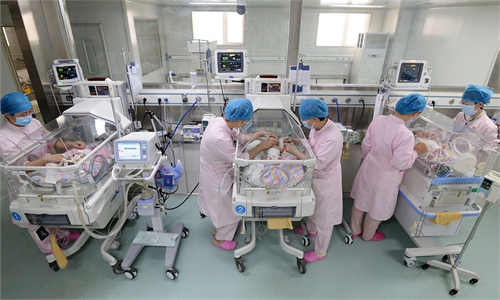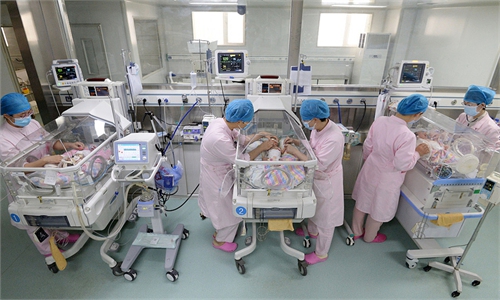
Photo taken on June 1, 2020 shows a job fair held at Jianghan University in Wuhan, Central China's Hubei Province. Photo:Xinhua
China's population continued to expand and employment has remained stable over the past decade, with the population policy constantly adjusted and optimized and multiple measures taken to promote employment and to improve employment structure, China's National Bureau of Statistics (NBS) announced on Monday.
According to NBS, China's total population grew steadily over the past decade. As of the end of 2021, China's population reached 1.41 billion, an increase of 53.38 million from the end of 2012, with an average annual growth of 5.93 million and an average annual growth rate of 0.4 percent. The average annual number of newborns amounted to 16.2 million between 2012 and 2021.
China has been facing a new demographic situation in recent years including a declining birth rate and aging population. Birth data for 2021 released by NBS shows that the number of new births in China in 2021 recorded 10.62 million, 1.38 million fewer than that in 2020 and a drop of 43.6 percent compared with the number in 2016.
Chinese demographers predicted that the growth rate of China's total population is expected to enter a negative growth during the 14th Five-Year Plan period (2021-25) and negative population growth will be the dominant trend in the coming years for a long time.
In response to this, China eased the one-child policy in 2013, allowing families to have two children, and further allowed Chinese families to have three children in 2021 in order to stimulate the birth rate.
With the implementation of the new two-child policy, yearly newborns reached 17.86 million and 17.23 million in 2016 and 2017 respectively.
Meanwhile, Chinese people's education level has been significantly improved, their life expectancy has increased and their health has continued to improve over the past decade, according to the NBS.
In 2020, the number of people with a senior high school education background or above reached 431.37 million, accounting for 30.6 percent of the population nationwide, 123.74 million more than in 2010.
In 2020, the average length of schooling of the working-age population between 16 and 59 years old reached 10.8 years, and 43.8 percent of the population group received senior high school education or above.
Since great importance has been attached to employment and preferential policies for employment have intensified, the employment situation has generally remained stable in China over the past decade.
Influenced by the aging population and the gradual decline of the working-age population, the total number of employed people peaked at 763.49 million in 2014 and then began to decrease. However, with the acceleration of urbanization, a large number of rural workers have moved to cities and towns where the employed population kept growing.
In 2021, the total urban employed population reached 467.73 million, an increase of 94.86 million from 2012, with an average annual growth of 10.54 million.
Meanwhile, China's unemployment rate has remained within a reasonable range thanks to the effective linkage of economic development and employment expansion.
Between 2018 and 2019, the surveyed urban unemployment rate remained stable at a relatively low level of around 5.0 percent. In early 2020, the employment situation was affected by the sudden COVID-19 epidemic with the unemployment rate rising to 6.2 percent in February.
However, as the economy continued to recover and various employment policies took effect, the surveyed urban unemployment rate started falling and dropped to 5.2 percent as of December 2020 and further to 5.1 percent as of December in 2021.
China has also endeavored to expand employment capacity and alleviate structural problems in employment to ensure stable employment for key groups such as college graduates and migrant workers.
Besides, the structure of employment in China has kept being optimized and the quality of employed personnel has been constantly improved over the past decade.
With the new round of scientific and technological revolution and the vigorous development of the digital economy, new industries and new business models are emerging every day. New jobs and positions such as big data engineers and technicians, drone pilots, online service deliverymen and internet marketing personnel are constantly being created.
The new economy has become an important channel to create jobs because of its large employment capacity, high salary level, flexibility and the option of part-time jobs.
According to a report on the development of the sharing economy released by the State Information Center, China's sharing economy platform enterprises employed 6.31 million people in 2020, about 1.31 million more than in 2015, and the platforms generated about 84 million jobs, up by about 34 million from 2015.
Global Times



